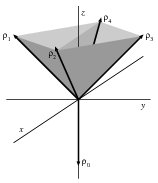 Toric Varieties
Toric Varieties
by
The Book
The study of toric varieties is a wonderful part of algebraic geometry
that has deep connections with polyhedral geometry. Our book is an
introduction to this rich subject that assumes only a modest knowledge
of algebraic geometry. There are elegant theorems, unexpected
applications, and marvelous examples that illustrate the scope and
power of modern algebraic geometry.
Contents of the Book
The book consists of fifteen chapters:

- Chapter 1: Affine Toric Varieties
- Chapter 2: Projective Toric Varieties
- Chapter 3: Normal Toric Varieties
- Chapter 4: Divisors on Toric Varieties
- Chapter 5: Homogeneous Coordinates on Toric Varieties
- Chapter 6: Line Bundles on Toric Varieties
- Chapter 7: Projective Toric Morphisms
- Chapter 8: The Canonical Divisor of a Toric Variety
- Chapter 9: Sheaf Cohomology of Toric Varieties
- Chapter 10: Toric Surfaces
- Chapter 11: Toric Resolutions and Toric Singularities
- Chapter 12: The Topology of Toric Varieties
- Chapter 13: Toric Hirzebruch-Riemann-Roch
- Chapter 14: Toric GIT and the Secondary Fan
- Chapter 15: Geometry of the Secondary Fan
There are also three appendices:
- Appendix A: The History of Toric Varieties
- Appendix B: Computational Methods
- Appendix C: Spectral Sequences
Publication Details
The book has been published by
the American Mathematical Society
as Volume 124 of
their Graduate
Studies in Mathematics series. Click
here
for the AMS page for the book.
Typographical Errors
A pdf file of typographical errors
is available for the book Toric Varieties.
Computer Algebra Packages for Toric Varieties
Appendix B of the book deals with computational methods in toric
geometry. The two main general-purpose toric packages mentioned in
the text are:
Here are two other general-purpose toric packages not discussed
in the book that may be of
interest:
The book also mentions the computer
packages Normaliz,
LattE,
PALP,
Polymake,
4ti2,
Gfan,
and TOPCOM,
and
the SageMath package
polyhedra. These
do more specialized tasks in parts of toric geometry (and many other
things as well).
Here are three additional specialized toric packages not mentioned in the book:
The book also mentions the Macaulay 2 package toriccodes by
Nathan Ilten (see reference [153] in the Bibliography).
This package is no longer maintained by the author.
Additional References
Here are some relevant references that appeared after publication
of the book:
- In the preface to the book, we give references for papers that deal
with toric varieties over an arbitrary field. Another paper to
check is the preprint
On Toric Schemes by Fred Rohrer
arXiv:1107.2713.
- The preface also gives a reference for toric stacks. Two more
papers on this subject by Anton Geraschenko and Matthew
Satriano are Toric Stacks I: The Theory of Stacky
Fans
arXiv:1107.1906 and Toric Stacks II: Intrinsic
Characterization of Toric
Stacks
arXiv:1107.1907.
- In Section 12.4, we give some references for introductions to
equivariant cohomology. Another introduction is Introduction to
equivariant cohomology in algebraic geometry (IMPANGA 2010) by
Dave Anderson
arXiv:1112.1421.
- The end of Section 8.3 mentions classification results for
reflexive polytopes. People have also studied smooth polytopes.
Here are two papers:
- Few smooth d-polytopes with N lattice points by Tristram
Bogart, Christian Haase, Milena Hering, Benjamin Lorenz, Benjamin
Nill, Andreas Paffenholz, Francisco Santos, Hal
Schenck
arXiv:1010.3887.
- A classification of smooth convex 3-polytopes with at most 16
lattice points by Anders
Lundman
arXiv:1206.4827.
- In Section 11.2, we discuss various versions of resolutions of
singularities. In 2003, Teissier asked if it is possible to perform
resolution of resolution of singularities inside an equivariant map
of toric varieties. An affirmative answer is given in the paper
On a Question of B. Teissier by Jenia
Tevelev
arXiv:1208.3173.
- A discussion of the toric minimal model program can be found in
the paper Birational Geometry of Toric Varieties by Edilaine
Ervilha Nobili
arXiv:1204.3883.
- A detailed discussion of weighted projective spaces from the
toric point of view can be found in the papers two papers Michele
Rossi and Lea Terracini: Weighted Projective Spaces from the
Toric Point of View with Computational
Applications
arXiv:1112.1677
and Computational Procedures for Weighted Projective Spaces
arXiv:1112.1673.
Nonnormal Toric Varieties
While nonnormal toric varieties are defined in Section 3.1 of the
book, most of the subsequent text assumes normality. Part of the
reason for this is that a nonnormal toric variety need not come from a fan (see
Example 3.A.1). However, when a nonnormal toric
variety has a torus-invariant affine open cover (automatic in the
normal case by Sumihiro's Theorem), then a nicer structure emerges.
Here are three references that explore what happens in this case:
- Fan is to Monoid as Scheme is to Ring: A Generalization of
the Notion of a Fan by Howard
Thompson
arXiv:math/0306221.
- Toric Geometry and the Semple-Nash Modification by
Pedro González Pérez and Bernard
Teissier
arXiv:0912.0593.
- Toric Varieties, Monoid Schemes and cdh Descent by
Guillermo Cortiñas, Christian Haesemeyer, Mark Walker and Charles
Weibel
arXiv:1106.1389.
- The Geometry of Toric Schemes by Fred
Roher
arXiv:1207.0605.
You can contact the authors at the following email addresses:
David Cox: dacox@amherst.edu
John Little: jlittle@holycross.edu
Hal Schenck: hks0015@auburn.edu
The web site for the book is:
http://dacox.people.amherst.edu/toric.html
 Toric Varieties
Toric Varieties Toric Varieties
Toric Varieties